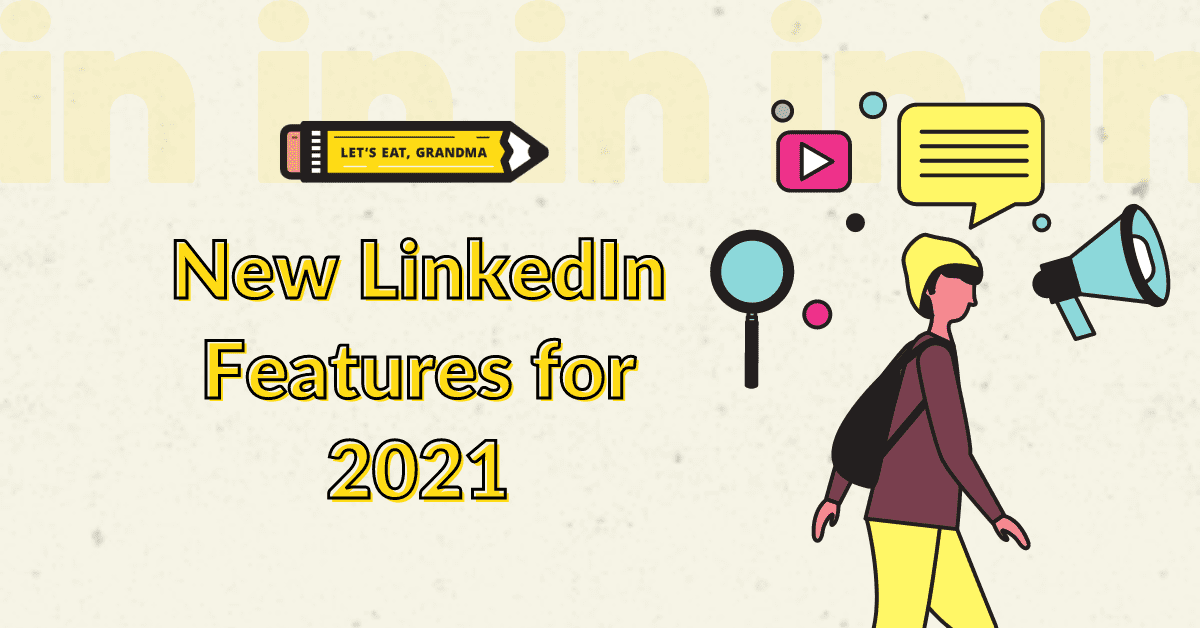How to Use the New LinkedIn Cover Story Video (and Other New LinkedIn Features)

LinkedIn just rolled out a couple of handy new features. Here’s how to use a LinkedIn cover story to optimize your job search.
By: Ryan Thornton | Contributor for Let’s Eat, Grandma
Along with the bloom of wildflowers, the return of migratory songbirds, and the reminder of how much of a bother mosquitoes can be, this spring brought two notable features for job seekers active on LinkedIn. These are:
- The video cover story for profiles
- New job titles to describe career gaps for things like raising kids and taking care of family members.
Taking these in order of when they arrived, let’s first take a look at the video cover story, then dig into these new job titles.
Ready for more job search help?
Sign up for a free Senior Writer Resume Critique to see what's holding you back from landing interviews. One of our top professional resume writers will give you personalized feedback on the top 3 items you can improve based on our expert practices!
LinkedIn Cover Story: Kind of Like Other Stories, But Not Really

The LinkedIn cover story lives in the profile photo section of your profile. Photo by inlytics | LinkedIn Analytics Tool on Unsplash
By now, many social media users are comfortable engaging their audience with stories that disappear after 24 hours, much like Instagram and Facebook. The LinkedIn cover story is similar in that it’s a short video that other people on the platform can view. Its function, however, is much more specific — it’s the first impression potential employers and colleagues may get when visiting your profile.
And, unlike a story on Instagram or Facebook, a low-effort cover story doesn’t simply disappear on its own after a day, so it’s got to be good.
Essentially, the cover story is a 20-second video that you upload to your profile from the LinkedIn mobile app. It “lives” in the same space as your profile picture and previews silently while others browse your page. Once someone clicks on the preview, the sound activates and they can watch your full story.
What Kind of Story to Tell
According to LinkedIn’s announcement, the cover story is perfect for “sharing your career goals, providing a peek at your personality and showcasing your communication skills,” all in less than half a minute.
Not everyone, though, is totally sold on the “sharing your goals” bit. In fact, Kamara Toffolo, career coach and LinkedIn consultant, disagrees entirely. According to Toffolo, a cover story is not at all the place for a career objective. Instead, it’s a moment to show your personality, connect with the viewer, and articulate how you offer what their organization needs.
The final product should look a little different for everyone. In part, that’s because you want to show a bit of your personal style, but also because your professional goals are uniquely yours. The cover story could be your moment to highlight your accomplishments, articulate your skills or expertise, or explain the services you provide. Whatever the case, your story should be written and directed to match your particular career path.
So You Want to Make a LinkedIn Cover Story?
A cover story is not an open invitation to hit record on your camera. Indeed, while a good cover story can help you establish a strong personal connection, a low-quality video can definitely diminish your profile.
In addition, there’s no denying that the camera likes to play favorites. There are things good lighting and savvy camerawork can fix and then there are … other things.
So if you happen to shine brighter on the page than on the screen, remember that this feature is still entirely optional. And, despite some evidence that video resumes are becoming more common, video stories are not usurping the written resume and cover letter anytime soon.
That said, before deciding against the cover story, take a few minutes to weigh the pros and cons.
The Good … and the Bad

The cover story is an opportunity to showcase your personality, but remember to stay professional. Photo by Marc Kleen on Unsplash
A video can get your personality into the job search straight away. This can be a huge advantage, especially if your interaction style matches a particular company culture. Unfortunately, a cover story may also make you subject to unconscious biases based on factors like your appearance or the way you speak.
In fact, some experts are seriously concerned about the very real potential for biases to enter the picture right off the bat with cover stories. You may recall that this is a primary reason why we do not recommend photos on resumes; ageism, sexism, and racism are all major issues, among others.
On the other hand, videos may offer more room for expression than a photo, which could present an opportunity to make a personal connection and counter unfair assumptions based on external factors like appearance or age. Older job seekers may find it useful to discuss their relevant skills and combat the ageist mindset of many employers.
Knowing this, you’ll have to decide for yourself whether a cover story is worth the risks. Whatever you decide, don’t hop in front of a camera out of a fear of being seen as passé. Wait until you feel comfortable with the technology and know what you want to say.
In the end, career gurus like Sonal Bahl, founder of SuperCharge, may turn out to be correct, that, “This tool is the future, and you need to keep up. There really isn’t much of a choice,” as Bahl recently told Forbes. If so, it’s possible that your profile may eventually start to look a tad incomplete if you avoid the cover story forever. For now, though, that’s not yet the case.
Before You Hit Record On Your LinkedIn Cover Story…
Going off the cuff here really isn’t an option for most of us, so the first step is to decide what you want to say and write it out word for word. Let a little go a long way here and don’t try to squeeze too much into the 20-second window.
Once you’ve got your script, you’ll want to choose your clothes and a well-lit place to record. (If it’s night, I recommend putting down the script until the next day.) Pick a spot facing a window to let the natural light work its magic on you. Just make sure the camera isn’t also facing a window, bright lights, or anything too distracting. As for your clothes, dress like you would for an interview at your dream company, but feel free to kick off the uncomfortable shoes since this video is shoulders up.
Record the video with your phone, since that’s where it will be uploaded. Stand your phone up in portrait mode on a phone stand, tripod, or against a stack of books so that your face is centered in the shot. Your phone’s internal microphone should also be fine for the audio as long as you’re inside in a relatively quiet space.
Perfect is Not Necessary
While your LinkedIn cover story should be genuine, compelling, and well-produced, it doesn’t need to completely knock anyone’s socks off or win an Emmy award. You’re just trying to show employers or clients a bit of who you are and what you bring to the table, so if try and have some fun while you’re at it.
The New Job Titles

LinkedIn hopes the new job titles will normalize career gaps created by time off taken for parenting. Photo by Standsome Worklifestyle on Unsplash
According to the folks over at LinkedIn, the stigma around employment gaps is really starting to fade, with 79% of hiring managers now open to hiring candidates with a career gap on their resume.
With that in mind, the company has added job titles like Stay-at-Home Mom, Stay-at-Home Dad, Stay-at-Home Parent, and Caregiver to the employment title dropdown box in an effort to keep things going in the direction of normalizing career gaps.
Progress or Pipe Dream?
As our readers know, the first steps of dealing with any employment gap are to define and then downplay it as much as possible. Then, for more significant gaps, you describe them, both in your cover letter and on your resume, or your LinkedIn profile.
In other words, longer employment gaps cannot be ignored, so having the option to choose from these new unpaid work titles could take some of the anxiety and headache out of the define part of the process. And, at least in theory, they might even prove critical in restoring dignity around personal choices like raising children or taking care of a loved one.
Carol Fishman Cohen, CEO and co-founder of iRelaunch, recently wrote for Harvard Business Review that the decision marks an “enormous step toward normalizing employment breaks as a common part of a career path. The significance of this development for the millions of people who have struggled to explain a resume gap cannot be overstated.”
Then there’s the counterpoint, which suggests that people using these new titles are likely to be harshly judged and passed over by some potential employers. Of course, LinkedIn is only one company, and even its director of engineering Bef Ayenew recently admitted to Fortune that the profile change is only a “stopgap” solution to a complex cultural problem. Some employers may get the message and others won’t.
Using the New Titles
To add a profile line for one of the new job titles, start a new employment entry as normal. In the title box, start typing in one of the new titles and select the one that fits your situation. Under the employment type box, LinkedIn recommends choosing “self-employed,” with the option of leaving the company name box blank.
Alternatively, some suggest filling in the company name box with an accurate descriptor of your situation, lest employers assume you were also working for yourself during that time. This could be something like “planned career break” or “professional active career break,” depending on your situation.
Next, fill in the dates and location and you’re all set. If none of these titles work for you, the company says it also plans to add new options for other types of career breaks as well, such as personal sabbaticals.
Your Move
Whether you choose to make use of these two features or neither of them is ultimately up to you. As discussed, there are some risks to consider in both instances. However, there may also be considerable risks to avoiding these tools, whether it’s the lost opportunity to connect with employers through a personal video or the confusion employers may have trying to discern why there’s a gap in your work experience. In the end, these features could be just what you need to make the difference in your job search.
Ready for more job search help?
Sign up for a free Senior Writer Resume Critique to see what's holding you back from landing interviews. One of our top professional resume writers will give you personalized feedback on the top 3 items you can improve based on our expert practices!
